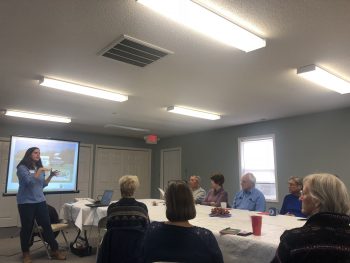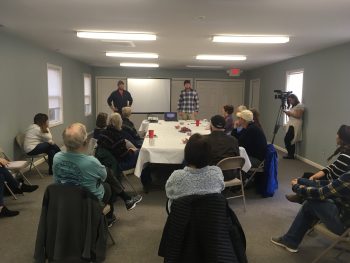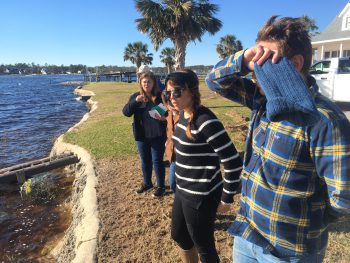On Nov. 27, the North Carolina Coastal Federation hosted their second Living Shoreline Open House at the central office. The open house allowed waterfront homeowners to learn more about what they can do to prevent shoreline erosion and damage on their property.

Rachel Bisesi giving living shoreline presentation
Several of the homeowners in attendance had experienced damage to their bulkhead after Hurricane Florence earlier this year and wanted to get more information on alternatives like living shorelines. After Hurricane Florence, many of the shorelines that the federation helped install had outperformed other traditional shoreline management techniques like bulkheads. As many of the homeowners in attendance are still in the rebuilding process, the open house provided new insight on how living shorelines could be beneficial to their properties since they have been proven to withstand major storms.
In addition to property owners, the crowd included federation staff members, Dr. Lexia Weaver, coastal scientist, and Rachel Bisesi, coastal education coordinator. The staff members presented on the basics of how living shorelines work and the permitting process for creating them.

Josh Merritt and Grainger Coughtrey from Carolina Silvics
Living shorelines are an erosion control method that can be used in place of a bulkhead or hardened structure on waterfront properties. Although there are several ways to build living shorelines, one technique includes using salt marsh grasses and bags of recycled oyster shells to buffer wave energy. When waves hit bulkheads, the energy bounces back and can cause more erosion to the shoreline in front of it. Living shorelines are able to absorb this wave energy and protect properties from storms because they follow the natural slope of the shoreline and are made with grasses native to the area.

Homeowners viewing living shoreline at Bogue Sound
Other attendees of the open house included Josh Merritt, vegetation management scientist, and Grainger Coughtrey, forestry technician, from Carolina Silvics. They both spoke with the homeowners individually about their properties and potential solutions to hurricane damage.
After the presentation, attendees were also given the opportunity to view a living shoreline at a private property along the Bogue Sound.
Check out local news coverage of this event here.
For more information on living shorelines visit nccoast.org/livingshorelines.
